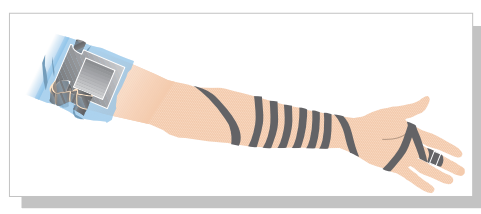Chapter 17: When to Remove the Tefillin
1) Strictly speaking, one may remove his tefillin after he recites the verse, “Kadosh kadosh kadosh” in the U’va Le’siyon section towards the end of shaharit.[85]
a. According to Kabbalistic teaching, however, one should not remove his tefillin until after the Kaddish Titkabal recited following U’va Le’siyon.[86]
b. According to the Arizal, one should not remove his tefillin until after he recites Aleinu.[87] In congregations where Kaddish Yatom (the mourners’ kaddish) is recited following Aleinu, one should not remove his tefillin until the conclusion of the Kaddish Yatom.[88]
2) On days when the Torah is read in the synagogue, it is customary not to remove one’s tefillin until after the Torah is returned to the Hechal (Ark).[89]
If, due to extenuating circumstances, one must remove his tefillin before the Torah is returned to the Hechal, he may not remove his tefillin shel rosh — thereby exposing his head — in the presence of the Torah. He should therefore move to the side of the synagogue before he removes his tefillin shel rosh. This does not apply if one wears a tallit gadol over his head, or if he is wearing a kippah, in which case his head is not exposed as he removes the tefillin shel rosh. However, one may remove his tefillin shel rosh in the presence of the Torah (even without a covering over his head) if the Torah is in a closed encasement.[90] One may remove his tefillin shel yad in the presence of the Torah.[91]
3) On Rosh Hodesh, one removes his tefillin just prior to the musafprayer, after the Torah has been returned to the Hechal. In the Kedushah service of musaf we speak of the “keter” (“crown”) of the Almighty, and it is inappropriate to wear tefillin — our “crown” — while describing the crown of G-d. We therefore remove the tefillin just before reciting the musaf service. The prevalent custom follows the position of the Arizal, that the tefillin should be removed after the kaddish that precedes musaf, before the Amidah.[92]
a. If one normally wears tefillin Rabbenu Tam after wearing the standard tefillin Rashi, on Rosh Hodesh he should preferably ensure to don his tefillin Rabbenu Tam before the musaf service. He may don the tefillin Rabbenu Tam anytime after the hazan’s repetition of the Amidah of shaharit. If he did not have the opportunity to put on tefillin Rabbenu Tam before musaf, he should do so after musaf.[93]
b. If a person forgot to add ya’aleh ve’yavo during shaharit on Rosh Hodesh, and he remembered his mistake only after the musaf prayer, such that he must recite a new Amidah, it is proper for him to put on his tefillin Rashi again before reciting the Amidah.[94]
c. If while wearing tefillin a person hears the kedushah of musaf recited by a different minyan, he should remove his tefillin, join in the recitation of kedushah, and then put on his tefillin again. If he does not have time to remove his tefillin before the recitation of kedushah, then he should quickly move his tefillin shel rosh to the side and insert his tallit or shirtsleeve in between the bayit of his tefillin shel yad and his arm before kedushah.[95]

4) If a berit milah (circumcision) is held in the synagogue immediately after the shaharit service, then one should not remove his tefillin until after the berit milah.[96]
a. Some have the custom that if the berit milah is conducted somewhere else, not in the place where shaharit was recited, then the child’s father, the mohel (person performing the circumcision) and the sandak (person who holds the infant) wear tefillin for the berit.[97]
b. On Rosh Hodesh, however, one does not put his tefillin on again to wear it during a berit milah that is conducted after musaf. The father, mohel and sandak simply wear a tallit, without tefillin.[98]
5) It is proper not to remove one’s tefillin until after he learns some Torah while wearing them. In particular, those who wear tefillin Rabbenu Tam should spend some time learning Torah before removing the tefillin Rabbenu Tam.[99]
6) It is improper to fold one’s tallit or tefillin during kaddish or while praying, as this detracts from the concentration that halachah requires. Just as it is forbidden to engage in any activity — even simple activities — while reciting a berachah, so should one refrain from folding a tallit or tefillin while listening to kaddish or praying.[100]
7) One should not remove his tefillin in the presence of his “Rav muvhak” — the Rabbi from whom he learned the majority of the Torah he has studied — as it is disrespectful to expose one’s head before his Rabbi. A person should therefore move to the side and remove his tefillin in a manner whereby he does not expose his head in front of his Rabbi, or keep his head covered by a tallit or kippah while removing his tefillin.[101]
(The halachot concerning removing one’s tefillin to wear tefillin Rabbenu Tam are discussed in the section entitled “Tefillin Rabbenu Tam.”)
Footnotes
- 85 - שו"ע כה:יג
- 86 - רמ"א ומשנ"ב שם
- 87 - משנ"ב וכה"ח שם
- 88 - משנ"ב, פמ"ג ושאר אחרונים
- 89 - שו"ע כה:יג
- 90 - עוד יוסף חי,פר' חיי שרה, אות ב
- 91 - משנ"ב שם
- 92 - שו"ע, כה"ח ומשנ"ב שם
- 93 - ילקוט יוסף
- 94 - ילקוט יוסף
- 95 - כף החיים שם
- 96 - משנ"ב כה:יג
- 97 - כה"ח שם
- 98 - כה"ח שם
- 99 - כה"ח כה:יג
- 100 - משנ"ב שם
- 101 - שו"ע לח:יא ומשנ"ב שם

